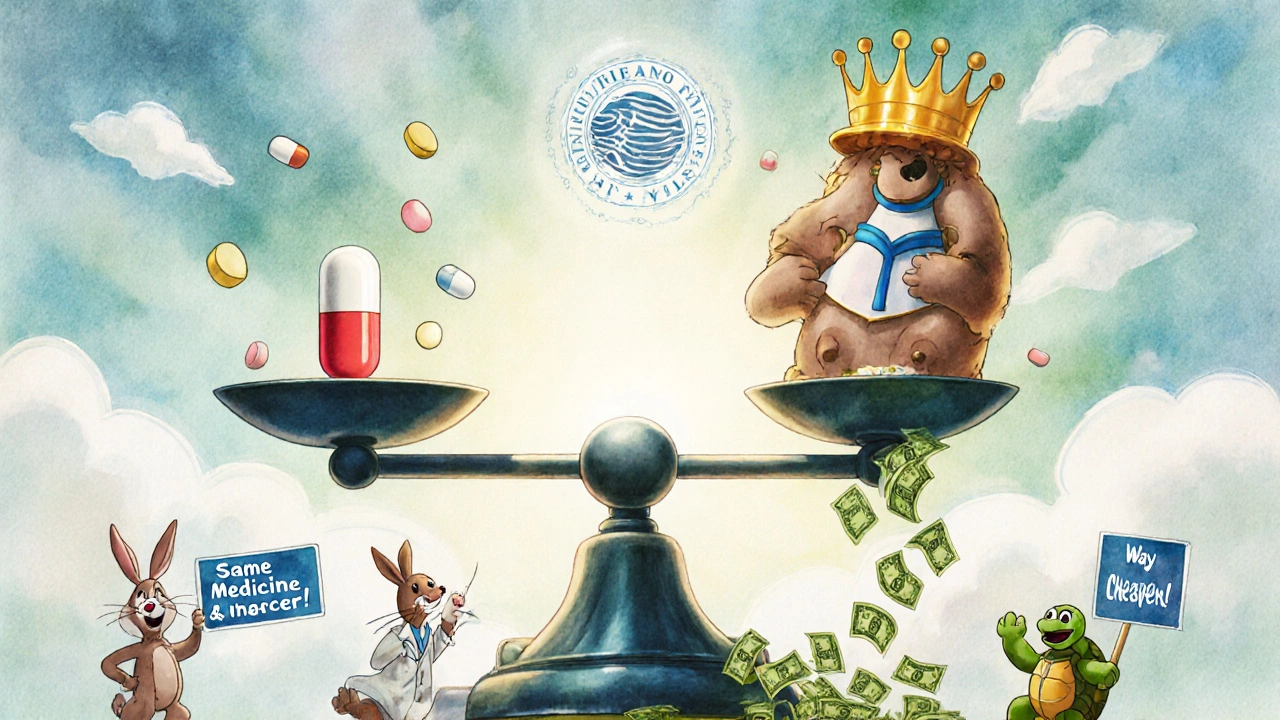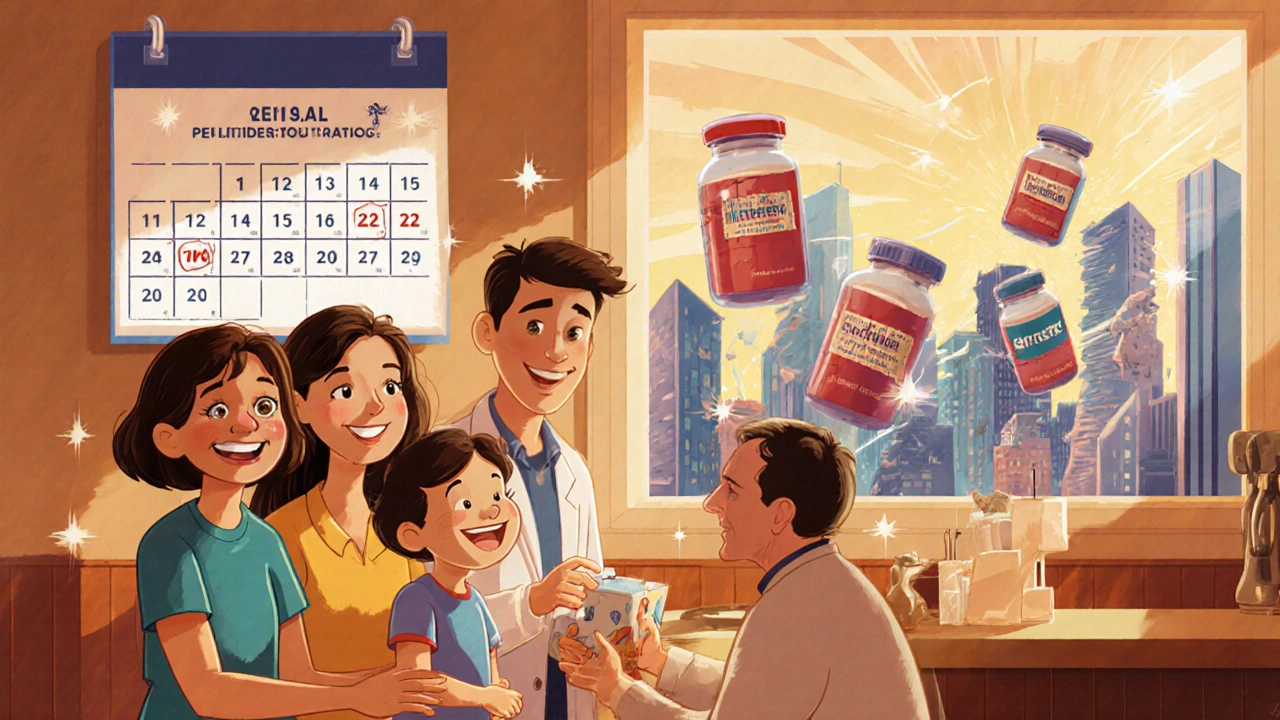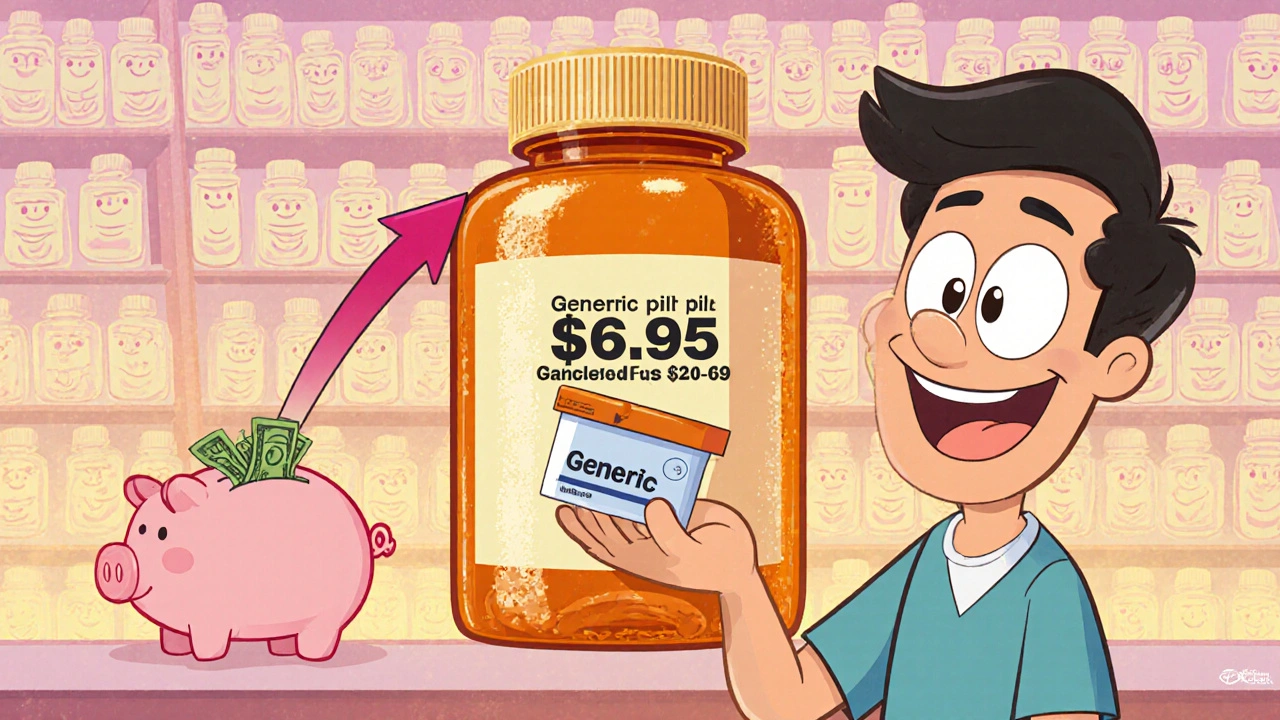Every year, Americans fill over 3.9 billion prescriptions for generic drugs. That’s nearly 9 out of every 10 prescriptions written. And yet, these same generics account for just 12% of total spending on prescription medications. Meanwhile, brand-name drugs-making up only 10% of prescriptions-consume 88% of the money spent. This isn’t a glitch. It’s the system working exactly as designed.
How Much Do Generics Actually Save?
In 2024, the average out-of-pocket cost for a generic prescription was $6.95. For the same medicine in brand-name form? $28.69. That’s more than four times as much. For someone taking three generic prescriptions a month, that’s $208.50 saved annually just on co-pays. Multiply that by millions of people, and you get the real picture: $445 billion in U.S. healthcare savings in 2023 alone from generic and biosimilar drugs.
Over the last decade, generics and biosimilars have saved Americans a total of $3.4 trillion. That’s not a theoretical number. It’s what families kept in their wallets instead of paying for insulin, blood pressure pills, or antidepressants. One study found that uninsured patients paid $130.18 per brand-name prescription in 2024-up 50% since 2019. The same drug as a generic? Just $6.95. That’s the difference between filling a prescription and skipping it.
Why Are Generics So Much Cheaper?
It’s not because they’re weaker or made with inferior ingredients. The FDA requires generics to have the same active ingredient, strength, dosage form, and route of administration as the brand-name version. They must also be bioequivalent-meaning they work the same way in your body. The only difference? No expensive clinical trials. Generics don’t need to repeat the years-long, billion-dollar testing that brand-name companies do.
The Hatch-Waxman Act of 1984 created the path for this. It let generic manufacturers submit an Abbreviated New Drug Application (ANDA), proving they match the brand without redoing every clinical study. That cut development time from 10-15 years to under 2. That’s why over 16,000 generic drugs are now available in the U.S.-and why the FDA approved 745 new ones in 2024 alone.
Brand Drugs Still Dominate Spending-Here’s Why
Even though generics fill 90% of prescriptions, they only make up 12% of spending. Brand drugs? 10% of prescriptions, 88% of the cost. That’s the 90/13 paradox-named by Dr. Aaron Kesselheim at Harvard. It’s not that generics are underused. It’s that brand-name prices are wildly out of control.
Take Entresto, a heart failure drug. In 2023, it brought in $5.4 billion in sales. When its patent expires in late 2025, multiple generic versions will hit the market. Experts estimate that could slash its price by 80-90%. Same with Tradjenta for diabetes and Opsumit for pulmonary hypertension. Together, those three drugs represent $8.6 billion in annual sales that could soon drop to a fraction of that.
But here’s the catch: brand companies don’t want that to happen. They use legal tricks-like patent thickets-to delay generics. One drug got over 75 patents, stretching its monopoly from 2016 all the way to 2034. That’s not innovation. That’s lock-in.

Biosimilars: The Next Big Savings Wave
Biosimilars are the generic version of complex biologic drugs-like those used for cancer, rheumatoid arthritis, and Crohn’s disease. They’re harder to copy than regular pills, but they’re still cheaper. Since their introduction, biosimilars have saved the U.S. healthcare system $56.2 billion. In 2024 alone, they saved $20.2 billion.
Stelara, a biologic for psoriasis and Crohn’s, had a list price of $7,000 per month. When nine biosimilar versions launched in mid-2025, prices dropped as much as 90%. That’s not a discount. That’s a revolution in access.
Yet, even with these wins, biosimilars only make up under 30% of the market in most cases. Why? Because doctors aren’t always told they’re safe. Pharmacies don’t always substitute them automatically. And insurers don’t always push them. That’s changing-but slowly.
Who’s Winning and Who’s Losing?
The winners? Patients. Medicare recipients. Medicaid programs. Employers. Pharmacy benefit managers (PBMs) who now require generic substitution in 87% of commercial plans.
The losers? Patients who can’t afford brand drugs. Rural clinics with limited formulary options. States that still haven’t updated pharmacy laws to allow pharmacists to substitute generics without a doctor’s note-only 42 states have done so as of December 2024.
Big Pharma still wins too, but not because of better drugs. They win because they control pricing, delay competition, and lobby against reform. In January 2025, major drugmakers raised prices on 250 brand-name drugs by an average of 4.5%-nearly double the inflation rate. Meanwhile, generic prices kept falling. Since 2019, total spending on generics dropped by $6.4 billion-even as more people used them and more generics entered the market.

What’s Changing in 2025?
The patent cliff is coming. Entresto, Tradjenta, and Opsumit will lose exclusivity by the end of the year. That’s over $8.6 billion in brand sales up for grabs. Analysts expect at least 10 generic versions of each to hit the market within months. Prices could drop by 80% or more.
Legislation is also shifting. The Affordable Prescriptions for Patients Act and the Drug Competition Enhancement Act both passed key committee votes in early 2025. They target patent thickets and “product hopping”-where companies make tiny changes to a drug just to reset the patent clock.
Kaiser Permanente saw pharmacy costs drop 25-35% within 18 months after tightening their generic substitution rules. That’s not magic. That’s policy.
Are Generics Always Safe?
Yes-for almost everyone. The FDA monitors adverse events closely. Less than 1% of generic prescriptions report any issues, and most of those are from narrow therapeutic index drugs-like blood thinners or seizure medications-where tiny differences matter. Even then, switching between generic manufacturers rarely causes problems.
If you’ve ever heard someone say, “My generic doesn’t work like the brand,” it’s usually because they’re comparing two different generics, or they’re noticing side effects from a new formulation. That doesn’t mean generics are unsafe. It means your body might need time to adjust. Talk to your pharmacist before switching.
What You Can Do Today
- Always ask if a generic version is available. Don’t assume your doctor already prescribed it.
- Use GoodRx or SingleCare to compare cash prices-sometimes generics cost less than your insurance co-pay.
- Ask your pharmacist if they can switch you to a different generic manufacturer if you feel a difference.
- Check your plan’s formulary. Some insurers have tiered pricing-generics are often Tier 1, meaning the lowest cost.
- If you’re on Medicare, ask about biosimilars for biologics like Humira or Enbrel. They’re now widely available and much cheaper.
You don’t need to wait for Congress to act. You can start saving today-just by asking the right questions.
Are generic drugs as effective as brand-name drugs?
Yes. The FDA requires generic drugs to have the same active ingredients, strength, dosage form, and bioequivalence as their brand-name counterparts. That means they work the same way in your body. Over 90% of prescriptions filled in the U.S. are generics, and studies consistently show they produce the same clinical outcomes.
Why are generic drugs so much cheaper?
Generic manufacturers don’t have to repeat expensive clinical trials. Thanks to the Hatch-Waxman Act of 1984, they only need to prove their drug is bioequivalent to the brand. That cuts development costs dramatically. Also, once multiple companies make the same generic, competition drives prices down-even further.
Can I trust generic drugs from different manufacturers?
Yes. All generic manufacturers must meet the same FDA standards. The FDA inspects their facilities and tests their products. While some people report slight differences in how a generic feels-like stomach upset or drowsiness-these are rare and usually due to inactive ingredients, not the active drug. Less than 1% of cases involve any issue, according to FDA data.
Do insurance plans cover generics better than brand-name drugs?
Almost always. Most insurance plans put generics in Tier 1-the lowest cost tier. Brand-name drugs are often Tier 2 or 3, meaning higher co-pays or coinsurance. Some plans even require you to try a generic first before approving the brand. That’s called step therapy-and it’s common.
What’s the difference between a generic and a biosimilar?
Generics are exact copies of small-molecule drugs, like pills for high blood pressure or cholesterol. Biosimilars are highly similar-but not identical-to complex biologic drugs, like injectables for cancer or autoimmune diseases. Biosimilars require more testing because they’re made from living cells, not chemicals. But they’re still much cheaper than the original biologic-and just as safe.
Will I save money if I switch to a generic?
Almost certainly. In 2024, the average out-of-pocket cost for a generic was $6.95. For the brand-name version? $28.69. That’s more than 75% less. For chronic conditions like diabetes or hypertension, switching to a generic can save hundreds or even thousands of dollars a year. If you’re uninsured, the difference is even starker-brand-name drugs can cost over $100 per prescription, while generics are often under $10.
Why aren’t more biosimilars available?
Because brand-name biologic makers use legal tactics to delay competition-like patent thickets, pay-for-delay deals, and marketing exclusivity tricks. Even though biosimilars have saved over $56 billion since 2015, they still make up less than 30% of the market in most cases. Regulatory barriers and lack of physician education also slow adoption. But that’s changing fast as more biosimilars get approved and prices drop.


Jennifer Skolney
November 23, 2025 AT 21:12Just switched my mom to generic insulin last month-her co-pay dropped from $120 to $8. 🙌 I didn’t even know this was possible until I read this. Thank you for laying it all out like this.
JD Mette
November 24, 2025 AT 17:47The math here is staggering. $3.4 trillion saved over a decade isn’t just a statistic-it’s millions of people keeping their homes, paying for childcare, or finally taking that vacation without guilt. This is public health infrastructure at its best.
Olanrewaju Jeph
November 25, 2025 AT 23:24As someone from Nigeria where brand-name drugs are often the only option due to supply chain issues, I find this data both inspiring and heartbreaking. The FDA’s regulatory framework for generics is a model the world needs to adopt. Access to medicine should not be a privilege.
Dalton Adams
November 26, 2025 AT 06:20Let’s be real-this isn’t about savings, it’s about corporate greed disguised as innovation. The fact that a single drug like Entresto can rake in $5.4 billion while patients ration pills is obscene. And don’t get me started on ‘product hopping’-it’s not innovation, it’s fraud. The Hatch-Waxman Act was supposed to fix this, but Big Pharma turned it into a loophole factory. I’ve seen the spreadsheets. The margins are insane. 90% profit on drugs that cost pennies to produce? That’s not capitalism-it’s extortion with a white coat.
And yes, I’ve read every FDA guideline, every ANDA filing, every patent filing from 2010 to 2024. The data doesn’t lie. Your ‘generic doesn’t work’? Probably your body adjusting to a different filler. Try a different manufacturer. Or better yet-ask your pharmacist to check the inactive ingredients. Most people don’t know that’s a thing.
Also, biosimilars are not ‘similar’-they’re 99.9% identical. The FDA doesn’t approve them with a wink and a nod. They’re held to the same standards as the original. If your doctor is hesitant, ask for the FDA’s biosimilar approval letter. They’ll have it. If they don’t, they’re just lazy or being paid to push the brand.
And before you say ‘but what about the R&D?’-nope. That’s already paid for. The patent clock resets when the exclusivity expires. The generic makers didn’t invent the molecule. They just made it affordable. That’s not stealing. That’s justice.
Also, GoodRx? Use it. Always. Even with insurance. I saved $140 on my blood pressure med last month just by paying cash. Insurers are not your friends. They want you to pay more so they can upsell you on ‘value-added’ services you don’t need.
TL;DR: Generics are safe, legal, and cheaper. The system is rigged. You’re not crazy for feeling ripped off. You’re just awake.
Kane Ren
November 27, 2025 AT 15:51This is the kind of info that changes lives. Seriously. If you’re on meds for anything chronic, go ask your pharmacist right now. You might be saving hundreds without even knowing it. Small steps, big impact.
Karla Morales
November 28, 2025 AT 11:54📊 Data Dive: In 2024, 88% of prescription spending went to 10% of drugs. That’s a Gini coefficient of 0.91 for pharmaceutical pricing-higher than any OECD country’s income inequality. The $445B in savings? That’s equivalent to the entire annual GDP of Denmark. The real scandal isn’t the price gap-it’s that we treat medicine like a luxury good. Biosimilars? Underutilized because of physician inertia, not safety. 73% of prescribers still default to originators out of habit. The system isn’t broken. It’s optimized for profit.
Javier Rain
November 30, 2025 AT 00:40I work in a rural clinic. We switched 80% of our patients to generics last year. No adverse events. No complaints. Just people who could finally afford their meds. This isn’t theoretical-it’s life-changing. Keep pushing this info. People need to know they’re not alone in this struggle.
Laurie Sala
December 1, 2025 AT 01:35Why do we keep pretending this is about health? It’s about money. And the people who profit? They’re not even in the same country. I cried when I saw my dad’s insulin bill. I cried again when I found out the generic cost less than my coffee. But no one talks about how this makes people feel-like they’re begging for the right to live.
Lisa Detanna
December 2, 2025 AT 06:15I’m from a family that moved from the Philippines to the U.S. We didn’t have insurance. My sister took a generic for asthma-$5 a month. In the Philippines, the same drug cost $40. The difference? Not the drug. The system. This isn’t just American-it’s global. And the fact that we’re finally talking about it? That’s hope.
Demi-Louise Brown
December 3, 2025 AT 10:54Generic drugs are not a compromise. They are a triumph of science and policy. The FDA’s rigorous standards ensure they are therapeutically equivalent. The savings are real. The access is life-saving. The resistance is outdated. Advocate. Ask. Switch. Your health deserves nothing less.